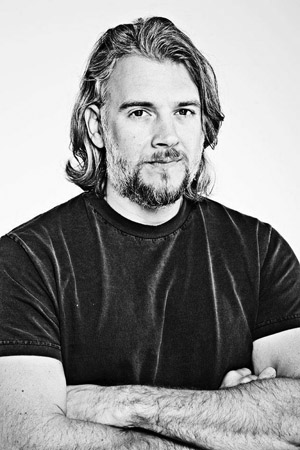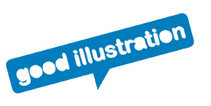Tell us about your career including what prompted you to enter the world of advertising.
I actually started out in college as a mechanical engineering major, despite the fact that I loved writing. It took me about three minutes to come to my senses. I had a buddy taking advertising classes, which seemed much cooler than multivariable calculus, so I switched. I graduated with an advertising degree and a terrible portfolio (I still have it in my drawer in my office). After one review with a recruiter, I realized my book desperately needed more work. So I spent a couple of years at the VCU Adcenter (now Brandcenter) whipping it into shape.
As Group Creative Director, what are your core responsibilities at DDB and how is your team structured?
I oversee the creative for our Clorox account, which includes everything with a Clorox logo on it as well as a number of other brands – Liquid Plumr, Pine-Sol, Glad, Kingsford, Brita, Fresh Step, Hidden Valley and a few more. I also oversee STP and Armor All creative.
We have a core leadership team for each of our accounts, which includes a creative, account, planning and production lead. Then, depending on the nature of each project, we custom build a team with the creative and other resources we have. The art director+copywriter team still happens, but more often there’s an interdisciplinary team that might include a designer, UX person, digital producer – whatever’s best for the project. It’s a lot messier than it used to be five years ago, but it leads to better, more interesting work.
Talk us through your creative process.
I’m a big believer in the creative wall where we hang things that represent ideas, moods, half-baked inklings, etc. I like to be able to move things around, see how they relate, and see what’s missing. To me, the wall is a physical manifestation of the team brain. Everyone can see what’s been thrown into the sandbox, what ideas we have to play with. Most of it will go away in the end, but during the process I like the ingredients to overstay their welcome.
In terms of process, it’s fill that wall, then pick what’s working and push that stuff forward. Blow it apart, put it back together in different ways. Fill the wall. It’s iterative. We go through that process several times, depending on what our deadline will allow, but those two parts – the expansion and contraction of ideas – that’s the creative process breathing. I try to really keep those two parts separate. You can’t breathe in and out at the same time.
The other important part is to know when it’s time to stop playing around with ideas and when it’s time to start assembling something concrete. You need time to craft, build, and work out the bugs. Whether it’s for a meeting, a presentation, or to ship, a big part of my job is to make sure we’re not at the deadline with a table full of unconnected parts.
What is the most successful campaign you have ever produced and how did the creative idea come about?
Depends how the success is measured, I guess. My favorite recent project is something I did with a group of friends for a little renegade wine company called SLO Down Wines. Some of us at the agency were searching out some interesting side projects and met these guys. Totally nuts, but very smart and ambitious.
I think any good idea needs to have an honesty to it. For this project, it was about portraying who these guys really are and the belief they have about their product: Screw all the pretension of Wine with a capital “w.” It’s a drink. It comes in a bottle. It makes you feel good. The concept just flowed out of that. Taking a convention of the wine industry – wine pairings – and injecting it with their f-you attitude.
Getting that stuff produced on a shoestring was a whole other challenge. We basically had a bunch of people, the creative, the production company, and the editors, who pitched in because they loved the ideas and loved what these guys were doing. We all just wanted to work with people we liked and have fun.
You are the co-author of the Makin’ Ads blog which offers ad students and junior creatives a plethora of advice. What is the most valuable piece of advice you have been given in your career and who have been your most significant mentors?
One of the reasons Greg Christensen and I started Makin’ Ads was to pass on all the great advice we got from others. We’ve both had a lot of great mentors over the years. It’s such a critical part of the ad business. To anyone going into advertising (or any creative field), find a mentor. Find a place that values mentorship.
When I started at Leo Burnett, I had some amazing mentors. Dave Reger and Mike Straznickas. Victor La Porte and Scott English. Those guys took me under their wings and gave me opportunities I hadn’t earned when I was just starting out. And Lisa Bennett, who I worked for at Burnett and then at DDB, believed in me throughout my career.
As for one piece of advice, Dave and Straz once told me that you will never have to produce something you hate if you only bring stuff you love to the meetings. There’s always someone willing to bring exactly what the client asks for or expects, which in a competitive agency environment can be tempting. Everyone wants to be the one to sell an idea. But there’s nothing worse than being stuck carrying around, caring for and polishing your own turd. Better to create only things you really love, even if it means fewer trips to L.A. for shoots or whatever.
What makes a stand-out portfolio?
I look for three things.
Big ideas. Obvious, I know, but if all I see are clever executions and one-off jokes, I pass. There needs to be some insight into human behavior, a campaign that I could see going on forever or an idea for something that would be really, truly useful to the world. A good litmus test is this question: Is there anything in this portfolio I wish I’d done myself?
Craft. Whether it’s writing or design, I need to see that someone knows how the details work and loves what they’re doing enough to pay attention to them. Craft = Knowledge + Passion
Voice. Is this person a one-trick pony? Does everything they do sound like or look like them? Because, for example, if I give someone briefs for Bud Light, Tampax and Intel, I need work that feels like each of those brands.
How is creativity nurtured at DDB and what does the creative environment look and feel like?
To paraphrase Austin Kleon, you are a mixtape of everything you take in. So we try to have a steady stream of inspiration, whether it’s scheduled emails about digital trends, presenters we bring in to talk to us over Friday breakfast, or just sharing things organically in the office. We send people to the conferences, award shows and all that and then ask them to share what they’ve learned.
As for the environment, we’re in the middle of a remodel, making the shift to more open seating, higher density, higher energy, more noise. It feels like Thanksgiving dinner inside a beehive.
What has been your most enjoyable client brief to date?
The brief that led to the Clorox “Bleachable Moments” campaign was fantastic. It basically said something like, “We all have moments in life that we wish we could undo.” It elevated Clorox bleach from cleaning to catharsis. It was a great starting point.
How do you feel about celebrities like Justin Tiberlake/MySpace, Lady Gaga/Polaroid taking on the role of Creative Director?
I remember MySpace and Polaroid.
But to answer your question, I’m fine with that. JT and Gaga are smart. They obviously know a lot about image. If they want to creative direct, I say go for it. If they fail, it shows it’s not as easy as one might think. And if they do amazing work, that pushes all of us, which is great. Some people will hate their work because they’re celebrities, others will love it for the same reason. But most people, I think and hope, will judge it for how good it is. I hope it’s great. I don’t like to root for people to fail.
This notion that they’re stepping onto our turf, or whatever, is kind of bogus. We talk all the time about how advertising is pop culture, yet we often present and produce ideas that feel entitled. “I’m paying for this media, so I can talk 30 seconds and people should listen. I have something important to say. It’s about me.” We all know people like that. Nobody likes them that much. If brands want to be loved, they need to think about what they can give. People like JT and Gaga understand the pressures of having to create content that people love. They’ve been successfully building their own brands for years. It’ll be interesting to see if they can do it with other brands.
What are some of the smartest ads out there right now?
I love the “Meet the Superhumans” spot for the Paralympics from last year. I love the production, the “origin story” insert shots and the Public Enemy track. It gives me goosebumps every time I watch it.
And although it’s not an “ad,” I love Beck’s “Song Reader,” also from last year. There are so many lame and safe ways to do user-generated content or to try to involve consumers in the brand, get them to co-author the story, whatever buzz phrase you want to use. How smart, risky and collaborative is it to just put out sheet music and say, “You want to hear the new album? Here you go. Play it.” Brilliant.
Headshot courtesy of Josh D. Weiss Photography







